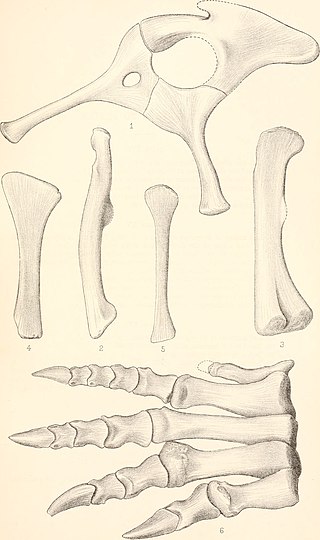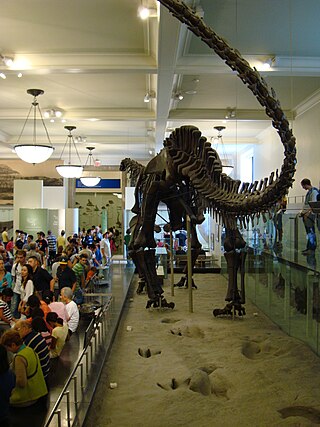
Barapasaurus is a genus of basal sauropod dinosaur from Jurassic rocks of India. The only species is B. tagorei. Barapasaurus comes from the lower part of the Kota Formation, which is of Early to Middle Jurassic age. It is therefore one of the earliest known sauropods. Barapasaurus is known from approximately 300 bones from at least six individuals, so that the skeleton is almost completely known except for the anterior cervical vertebrae and the skull. This makes Barapasaurus one of the most completely known sauropods from the early Jurassic.

Titanosaurus is a dubious genus of sauropod dinosaurs, first described by Richard Lydekker in 1877. It is known from the Maastrichtian Lameta Formation of India.

Vulcanodon is an extinct genus of sauropod dinosaur from the Early Jurassic of southern Africa. The only known species is V. karibaensis. Discovered in 1969 in Zimbabwe, it was regarded as the earliest-known sauropod for decades, and is still one of the most primitive sauropods that has been discovered. As a quadrupedal, ground-dwelling herbivore, Vulcanodon already showed the typical sauropod body plan with column-like legs and a long neck and tail. It was smaller than most other sauropods, measuring approximately eleven metres (36 ft) in length. Vulcanodon is known from a fragmentary skeleton including much of the pelvic girdle, hindlimbs, forearms, and tail, but lacking the trunk and neck vertebrae as well as the skull.

Shunosaurus, meaning "Lizard from Sichuan", is a genus of sauropod dinosaur from Late Jurassic (Oxfordian) beds in Sichuan Province in China, from 161 to 157 Million years ago. The name derives from "Shu", an ancient name for the Sichuan province.
Zizhongosaurus is a genus of basal herbivorous sauropod dinosaur which lived in the Early Jurassic (Toarcian) Period of China. It was a large-bodied herbivore characterized by a long neck.

Tazoudasaurus is a genus of gravisaurian, probably a vulcanodontid sauropod dinosaurs hailing from the late Early Jurassic (Toarcian), that was recovered in the "Toundoute Continental Series" located in the High Atlas Mountains of Morocco in North Africa. Along with Patagosaurus, Volkheimeria, Bagualia and Perijasaurus represents one of the few sauropods named from this stage on Gondwana, as well the only one from Africa.
Volkheimeria is an extinct genus of sauropod dinosaurs that lived in what is now Argentina during the Early Jurassic, 178–179 million years ago. Its type and only species is Volkheimeria chubutensis.

Sanpasaurus is a poorly known sauropod dinosaur from the Early to Late Jurassic of Sichuan, China. The type species, S. yaoi, was described by Chung Chien Young, in 1944. The type remains, IVPP V.156, consists of 20 vertebrae, scapulae, forelimbs, and some hindlimb bones. Initially reported by Young as an ornithopod ornithischian, this specimen was unambiguously referred to Sauropoda in 2016 by McPhee et al., later refined to a basal gravisaurian position by Pol et al. in 2020 and 2022, closely related to Vulcanodon and Tazoudasaurus. Sanpasaurus is known from remains recovered from the Maanshan Member of the Ziliujing Formation.

Euskelosaurus is a sauropodomorph dinosaur from the Late Triassic of South Africa and Lesotho. Fossils have only been recovered from the lower Elliot Formation in South Africa and Lesotho, and in one locality in Zimbabwe.

Gryponyx is an extinct genus of massopod sauropodomorph known from southern Free State, central South Africa.

Histriasaurus (HIS-tree-ah-SAWR-us) was a genus of dinosaur from the Early Cretaceous. Its fossils, holotype WN V-6, were found in a bonebed in lacustrine limestone exposed on the seafloor off the coast of the town of Bale on the Istrian peninsula in Croatia by Dario Boscarolli during the 1980s, and described in 1998 by Dalla Vecchia. It was a diplodocoid sauropod, related to, but more primitive than, Rebbachisaurus. Phylogenetic analyses published in 2007 and 2011 placed Histriasaurus as the most basal member of Rebbachisauridae.
Gongxianosaurus is a genus of basal sauropod dinosaur from the early Jurassic Period. The only species is Gongxianosaurus shibeiensis. Based on four fragmentary to complete specimens found in China, it is one of the most completely known early sauropods. The skeleton is known in large part, missing both the hand and the majority of the skull. Gongxianosaurus was firstly named and described in a short note published in 1998; however, a comprehensive description has yet to be published. Gongxianosaurus shibeiensis was named for the place it was found, near the village Shibei in Gong County.

Kotasaurus is a genus of sauropod dinosaur from the Early Jurassic period (Sinemurian–Pliensbachian). The only known species is Kotasaurus yamanpalliensis. It was discovered in the Kota Formation of Telangana, India and shared its habitat with the related Barapasaurus. So far the remains of at least 12 individuals are known. The greater part of the skeleton is known, but the skull is missing, with the exception of two teeth. Like all sauropods, it was a large, quadrupedal herbivore with long neck and tail.

Ohmdenosaurus is a genus of sauropod dinosaur that lived during the Early Jurassic epoch in what is now Germany. The only specimen – a tibia (shinbone) and ankle – was discovered in rocks of the Posidonia Shale near the village of Ohmden. The specimen, which was originally identified as a plesiosaur, is exhibited in a local museum, the Urweltmuseum Hauff. In the 1970s, it caught the attention of German palaeontologist Rupert Wild, who recognised it as the remains of a sauropod. Wild named Ohmdenosaurus in a 1978 publication; the only known species is Ohmdenosaurus liasicus.

Camarasauridae is a family of sauropod dinosaurs. Among sauropods, camarasaurids are small to medium-sized, with relatively short necks. They are visually identifiable by a short skull with large nares, and broad, spatulate teeth filling a thick jaw. Based on cervical vertebrae and cervical rib biomechanics, camarasaurids most likely moved their necks in a vertical, rather than horizontal, sweeping motion, in contrast to most diplodocids.

Eusauropoda is a derived clade of sauropod dinosaurs. Eusauropods represent the node-based group that includes all descendant sauropods starting with the basal eusauropods of Shunosaurus, and possibly Barapasaurus, and Amygdalodon, but excluding Vulcanodon and Rhoetosaurus. The Eusauropoda was coined in 1995 by Paul Upchurch to create a monophyletic new taxonomic group that would include all sauropods, except for the vulcanodontids.

Aardonyx is a genus of basal sauropodomorph dinosaur. It is known from the type species Aardonyx celestae found from the Early Jurassic Elliot Formation of South Africa. A. celestae was named after Celeste Yates, who prepared much of the first known fossil material of the species. It has arm features that are intermediate between basal sauropodomorphs and more derived sauropods.
Gravisauria is a clade of sauropod dinosaurs consisting of some genera, Vulcanodontidae and Eusauropoda.

The 20th century in ichnology refers to advances made between the years 1900 and 1999 in the scientific study of trace fossils, the preserved record of the behavior and physiological processes of ancient life forms, especially fossil footprints. Significant fossil trackway discoveries began almost immediately after the start of the 20th century with the 1900 discovery at Ipolytarnoc, Hungary of a wide variety of bird and mammal footprints left behind during the early Miocene. Not long after, fossil Iguanodon footprints were discovered in Sussex, England, a discovery that probably served as the inspiration for Sir Arthur Conan Doyle's The Lost World.

Australotitan is an extinct genus of possibly titanosaurian somphospondylan dinosaurs from the Late Cretaceous Winton Formation (Cenomanian–Turonian) of southern-central Queensland, Australia. The genus contains a single species, A. cooperensis, known from multiple partial skeletons. The genus Australotitan may be synonymous with Diamantinasaurus, a contemporary relative.




























